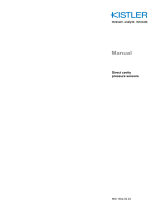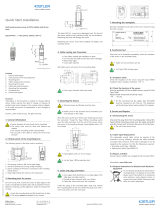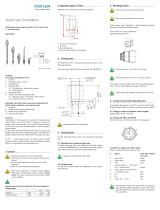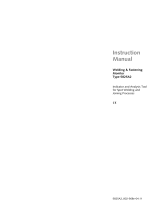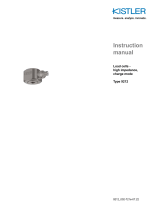Page is loading ...

Instruction
Manual
Surface Strain
Transmitter
Type 9238B...
9238B_002-542e-02.23


Foreword
9238B_002-542e-02.23 Page 1
Foreword
Thank you for choosing a Kistler quality product character-
ized by technical innovation, precision and long life.
Information in this document is subject to change without
notice. Kistler reserves the right to change or improve its
products and make changes in the content without obliga-
tion to notify any person or organization of such changes
or improvements.
© 2011 … 2023 Kistler Group. Kistler Group products are
protected by various intellectual property rights. For more
details visit www.kistler.com. The Kistler Group includes
Kistler Holding AG and all its subsidiaries in Europe, Asia,
the Americas and Australia.
Kistler Group
Eulachstrasse 22
8408 Winterthur
Switzerland
Tel. +41 52 224 11 11
www.kistler.com

Surface Strain Transmitter, Type 9238B...
Page 2 9238B_002-542e-02.23
Content
1.Introduction ................................................................................................................................... 4
2.Important notes .............................................................................................................................. 5
2.1For your safety ..................................................................................................................... 5
2.2Unpacking ..................................................................................................................... ....... 6
2.3Notes on using the transmitter ............................................................................................. 6
2.4Hints on using this instruction manual .................................................................................. 6
3.General description ........................................................................................................................ 7
3.1What is strain? ..................................................................................................................... 7
3.1.1NormalsStrain – shear strain .................................................................................... 7
3.2What is the purpose of a strain transmitter? ......................................................................... 8
3.3Design and principle of operation of strain transmitter Type 9238B... .................................. 9
3.3.1Design ..................................................................................................................... 9
3.3.2Measurement principle .......................................................................................... 10
3.3.3Integral fully-digital charge amplifier ..................................................................... 10
3.4Factory calibration of transmitter ........................................................................................ 11
4.Installation and commissioning ................................................................................................... 13
4.1Important instructions ........................................................................................................ 13
4.2Choosing measuring point .................................................................................................. 13
4.2.1Surface materials ................................................................................................... 14
4.3Allowing for thermal effects ............................................................................................... 15
4.3.1Self-heating ........................................................................................................... 16
4.4Machining mounting surface .............................................................................................. 16
4.5Mounting ........................................................................................................................... 18
4.5.1Mounting strain transmitter ................................................................................... 18
4.6Connecting strain transmitter Type 9238B... ...................................................................... 19
4.6.1Notes on cable laying ............................................................................................ 19
4.6.2Connecting strain transmitter Type 9238B............................................................. 20
4.6.3Cable concept ....................................................................................................... 22
4.7Commissioning ................................................................................................................... 23
4.7.1Simplest form of measurement – relative ............................................................... 23
4.7.2Simplest form of measurement – strain .................................................................. 24
4.7.3Range switching .................................................................................................... 25
4.7.4Indirect force measurement ................................................................................... 26
5.Calibration and maintenance ....................................................................................................... 27
5.1In-Situ calibration of surface strain transmitter Type 9238B... ............................................. 27
5.1.1Working point calibration by peak value comparison ............................................ 27
5.1.1.1Test system requirements ....................................................................... 28
5.1.1.2Reference sensor installation .................................................................. 28
5.1.1.3Load application ..................................................................................... 29
5.1.1.4Calibration process worksheet ................................................................ 30

Introduction
9238B_002-542e-02.23 Page 3
5.2Kistler calibration service ..................................................................................................... 31
6.Operation ..................................................................................................................................... 32
6.1Setting up strain transmitter Type 9238B... with ManuWare ............................................... 32
6.1.1Configuration examples ......................................................................................... 36
6.2Resolution of measurement signal ....................................................................................... 38
6.3Quasistatic measurements .................................................................................................. 38
6.4Tips for good measurements ............................................................................................... 38
7.Maintenance ................................................................................................................................. 39
7.1Overload protection ............................................................................................................ 39
7.2Maintenance ....................................................................................................................... 39
8.Remedying faults .......................................................................................................................... 40
8.1Troubleshooting and remedying faults ................................................................................ 40
8.2Repairing strain transmitter ................................................................................................. 40
8.3Technical data ..................................................................................................................... 41
8.4Dimensions of Type 9238B… .............................................................................................. 43
8.5Pin allocation ...................................................................................................................... 43
8.6Ordering key ....................................................................................................................... 44
8.7Included accessories ............................................................................................................ 44
8.8Optional accessories ............................................................................................................ 44
9.Annex ........................................................................................................................................... 45
9.1Glossary .............................................................................................................................. 45
9.2Measurement uncertainty ................................................................................................... 48
9.3Linearity .............................................................................................................................. 49
9.4Frequency range ................................................................................................................. 51
9.5Influence of temperature .................................................................................................... 52
10.Index ............................................................................................................................................. 54
Total Pages 55

Surface Strain Transmitter, Type 9238B...
Page 4 9238B_002-542e-02.23
1. Introduction
Please take the time to thoroughly read this instruction
manual. It will help you with the installation, maintenance,
and use of this product.
To the extent permitted by law Kistler does not accept any
liability if this instruction manual is not followed or prod-
ucts other than those listed under Accessories are used.
Kistler offers a wide range of products for use in measuring
technology:
Piezoelectric sensors for measuring force, torque, strain,
pressure, acceleration, shock, vibration and acoustic
emission
Strain gage sensor systems for measuring force and
moments
Piezoresistive pressure sensors and transmitters
Signal conditioners, indicators and calibrators
Electronic control and monitoring systems as well as
software for specific measurement applications
Wireless data transmission modules
Kistler also develops and produces measuring solutions for
the application fields of engines, vehicles, manufacturing,
plastics and biomechanics sectors.
Our product and application brochures will provide you
with an overview of our product range. Detailed data
sheets are available for almost all products.
If you need additional help beyond what can be found
either on-line or in this manual, please contact Kistler's
extensive support organization.

Important notes
9238B_002-542e-02.23 Page 5
2. Important notes
It is essential for you to study the following notes, which
are for your personal safety during work, and to ensure
long term, fault-free operation of this product.
2.1 For your safety
This product has been thoroughly tested and has left
the factory in a perfectly safe condition. In order to
maintain this condition and ensure safe operation, com-
pliance is required with the instructions and warning
notes in this instruction manual.
The press force sensor must be installed, operated and
maintained only by persons who are familiar with this
product and who are adequately qualified for the work
involved.
If it is to be assumed that safe operation is no longer
possible, the equipment must be shut down and made
safe against being accidentally started up.
Safe operation must be assumed to be no longer possible
when the product
shows visible signs of damage,
has been overloaded,
is no longer operating,
has been in lengthy storage under unsuitable conditions
and,
has been subjected to rough transport conditions.
Install the surface strain transmit
t
e
r
in
p
osition as
pr
e-
scribed. Details can be found in section 4.2.

Surface Strain Transmitter, Type 9238B...
Page 6 9238B_002-542e-02.23
2.2 Unpacking
Check all packaging for transport damage. Report any such
damage to the transporters and to the authorized Kistler
distributor.
Check accessories delivered (see section 8.7), before first
use of the equipment. Report any missing parts to the au-
thorized Kistler distributor.
2.3 Notes on using the transmitter
The surface strain transmitter must be used only under
the environmental and operating conditions specified.
Protect the connector of the surface strain transmitter
sensor against contamination and on no account touch
it with your fingers (connector front). Fit the cover sup-
plied over the connector when it is not in use.
Use only specified connecting cables.
Protect the surface strain transmitter when it is not in
use by storing it in its original packaging.
2.4 Hints on using this instruction manual
We recommend that you read the entire instruction manu-
al carefully. However, if you are in a hurry and already
have experience with Kistler surface strain transmitter, read
the specific information needed.
We have attempted to give these instructions a clear
presentation to make it easier for you to gain direct access
to the information you need.
Please keep this instruction manual in a safe place where
you can retrieve it at any time.
If you lose this instruction manual, please contact your
Kistler distributor and ask them for an immediate replace-
ment.

General description
9238B_002-542e-02.23 Page 7
3. General description
3.1 What is strain?
The physical measurand that is measured is the relative
measure of strain and is defined as the change in length
of a part of a machine under load divided by the original
length l0.
If the dimension of the body increases, one talks in terms
of a positive strain (or tensile strain), otherwise of a nega-
tive strain (or compressive strain).
The measurand is dimensionless. The SI unit of strain as
a relative measure is [m/m].
Kistler uses as the unit for relative strain
1 = 1 microstrain = 10–6 m/m = m/m
3.1.1 NormalsStrain – shear strain
Any component stretched or compressed longitudinally ex-
periences a shear strain in the transverse direction. The
shear strain is usually approximately 30 % of the normal
strain in the opposite direction. If the component is, for ex-
ample, compressed in the longitudinal direction, it stretches
in the transverse direction. Depending on the application,
this effect can be exploited and accordingly the shear strain
measured instead of the normal strain.
Fig. 1: Any body stretched or compressed in one direc-
tion experiences the opposite strain in the trans-
verse direction.
m
m
l
l
l
ll
00
01

Surface Strain Transmitter, Type 9238B...
Page 8 9238B_002-542e-02.23
3.2 What is the purpose of a strain transmitter?
A strain transmitter is primarily used to measure the surface
strain of a structure. However, as in all processes in which
forces are applied, the load-bearing structure of the ma-
chine undergoes a greater or lesser tensile or compressive
strain, a strain transmitter can be used equally effectively
for indirect measurement of dynamic and quasistatic forc-
es (see Figure 2). The sensitivity of the indirect force meas-
urement has to be determined by means of in-situ calibra-
tion.
Fig. 2: Indirect force measurement using strain forms
one extreme of the above spectrum. Despite
lower sensitivity, the relationship between force
and strain is in most cases linear enough to allow
sufficiently accurate measurement and monitor-
ing.
The key areas of application of the strain transmitter Type
9238B... are:
Process monitoring of medium forces
(press-fitting, crimping, bonding, punching, fine blank-
ing, deep drawing and embossing)
Process monitoring in presses exerting large forces
(for forging and production of car bodies, etc.)
Machine tool monitoring
<10 %
10 ... 99 %
>> 99 %
Force shunt measurement
Sensitivity
Fp
Fn
Fs
Fp
Indirect force measuremen
t
Force Shunt
Direct force measuremen
t
Range of
indirect force
measurement
using strain

General description
9238B_002-542e-02.23 Page 9
1
The strain transmitter Type 9238B... has the following ex-
cellent features:
Simple mounting with just a single M6 hexagon socket
head cap screw
Integral charge amplifier makes it particularly good val-
ue for money
Flexible adjustment of the output signal thanks to fully-
digital amplifier
Absolute protection against overload
The Kistler strain transmitter Type 9238B... is supplied cali-
brated and is ready for immediate use.
3.3 Design and principle of operation of strain transmitter Type 9238B...
3.3.1 Design
Fig. 3: Schematic section through strain transmitter Type
9238B…
The strain transmitter 9238B... basically consists of five vital
elements.
1 Machine structure that is being stretched or compressed
cyclically.
2 Two contact feet of the strain transmitter transfer the
strain of the structure by friction to the body of the sen-
sor and to the piezoelectric element for measuring shear
force.
3 Piezoelectric measuring element, which generates a
charge proportional to the applied shear force.
4 Sensor case or body, which acts as a spring converting
the strain into a proportional force.
5 Amplifier case containing the fully digital charge ampli-
fier, which converts the charge generated by the meas-
uring element into a standard 0 ... 10 V voltage signal.
2
3
4 5
1
2
3
4 5

Surface Strain Transmitter, Type 9238B...
Page 10 9238B_002-542e-02.23
3.3.2 Measurement principle
To enable the strain of the structure of the machine to be
transferred by friction to the strain sensor, the contact feet
(2) have to be pressed onto the surface of the structure
with a preloading force acting perpendicular to the bear-
ing surface.
The design of the strain transmitter Type 9238B... allows
the bearing surfaces (or contact feet (2)) to be preloaded
through the case with a single M6 screw.
The strain of the material forming the structure (of the ma-
chine) acts on the surface of the structure as a change in
length. As the strain transmitter is firmly connected to the
surface, the distance between the two contact feet chang-
es with the strain. This change in distance is picked up by
the body of the sensor (Figure 3, (4)) and converted into a
strain-proportional shear force, which acts on the piezoe-
lectric measuring element (Figure 3, (3)).
The transmitter is designed so that a strain generates a
negative charge. The integral charge amplifier standardly
converts this into a positive output signal according to a
Kistler convention. The signs change accordingly for com-
pressive strain.
3.3.3 Integral fully-digital charge amplifier
The strain transmitter Type 9238B... is equipped with a mi-
croprocessor-controlled, highly-integrated charge amplifier.
This offers the user very considerable flexibility. Via the se-
rial interface (RS-232C):
all parameters can be set
the measuring cycle can be controlled
(MEASURE/RESET).
the measuring range can be switched
measurement data can be transmitted (20 Hz).

General description
9238B_002-542e-02.23 Page 11
Fig. 4: Block circuit diagram of strain transmitter Type
9238B...
The charge amplifier with preamplifier is designed using
proven high-insulation technology. After this stage the
output signal of the preamplifier is digitized at 1 kHz and
processed in the microcontroller. Full scale voltage, offset
and signal inversion are calculated digitally in real time. The
calculated output value is converted into the analog output
signal in a digital-to-analog converter. As usual the two
process control signals /Range II and /Measure can also
control the transmitter from the process controller by
means of hardware.
3.4 Factory calibration of transmitter
The strain transmitter Type 9238B... is calibrated by the
factory. This involves determining the actual sensitivity and
the maximum linearity error using the method of 'continu-
ous calibration'. Calibration is performed for the range
0 ... –500 ; with the transmitter programmed to
500 /10 V and 50/10 V (mechanical measuring range
/ full scale output) respectively. The calibration is recorded
on the included calibration certificate.

Surface Strain Transmitter, Type 9238B...
Page 12 9238B_002-542e-02.23
Fig. 5: Example of an included calibration certificate
The results of factory calibration can be used for direct
measurement of strain. The shown sensitivity can be used
by the postprocessing system (e.g. data acquisition) to cor-
rectly interpret the output signal (e.g. 200,8 mV corre-
sponds to 1 with the nominal setting of 50 /10 V).
If the strain transmitter Type 9238B... is to be used for indi-
rect force measurement, in-situ calibration has to be carried
out in any case.

Installation and commissioning
9238B_002-542e-02.23 Page 13
4. Installation and commissioning
4.1 Important instructions
The strain transmitter Type 9238B... is a precision instru-
ment whose specifications can only be fully exploited with
correct use and only retained with careful handling. Please
observe the following instructions:
The strain transmitter may only be installed by persons
adequately qualified for this work.
Do not drop the strain transmitter or hit it hard! The
peak of such a shock force can cause permanent dam-
age.
Do not use a hammer to position the workpieces, as
such blows can also lead to damage!
Please see the following sections for instructions for in-
stalling the strain transmitter and setting up the measuring
chain.
4.2 Choosing measuring point
To enable successful indirect measurement, particular at-
tention must be paid to the choice of measuring point.
Measuring chain requirements:
The strain at the measuring point must be as propor-
tional as possible to the force to be measured.
A machine that does not allow exact location of the
point of application of the force must be fitted with
several strain sensors or transmitters if measurement
always has to be correspond accurately to the operating
force (for instance in a 4-column press, 2 or 4 sensors
are required) irrespective of the force application point.
On the one hand the strains at the measuring point
have to lie within the measuring range of the sensor.
On the other hand, to get a signal-to-noise ratio as
large as possible in operation it must be ensured that
the measuring range of the strain sensor is optimally
exploited.
The measuring point should not be subjected to any
high thermal loads (heat radiation and air currents).
Ideally, the material and ambient temperature at the
measuring point are equal and constant during the
measuring cycle.
The material of the surface must have sufficient wall
thickness at the measuring point.

Surface Strain Transmitter, Type 9238B...
Page 14 9238B_002-542e-02.23
It is scarcely possible to find measuring points on machines
whose strains are the result of pure tensile and compressive
stresses. At practically every measuring point the strain is a
combination of tensile or compressive and bending stress-
es. The percentage of the strain due to bending is often
considerably higher than that due to pure tension or com-
pression. More accurate investigation of the relationship
between strain due to bending and working force fre-
quently reveals nonlinear characteristics, whose cause is to
be found in the spring effects of gaps between bearing and
flange surfaces, or in effects related to the sliding of the
faces of joints. Such nonlinearities become apparent during
working force calibration, when the relationship between
reference force and strain signal is being measured.
4.2.1 Surface materials
The transmitter is basically intended for use on steel struc-
tures, which do not present any problems. Measurement of
strain on other materials, such as cast iron, aluminum or
other metals, must be approached with caution. Known
problems include reduced surface pressure and hence re-
duced preloading, hysteresis effects, material fatigue in the
contact area and insufficient mounting thread strength.
Although we do not advise here against trials on alterna-
tive materials, it is necessary to clarify the prospects of suc-
cess on a case by case basis, possibly with the aid of tests.

Installation and commissioning
9238B_002-542e-02.23 Page 15
4.3 Allowing for thermal effects
Any setup used to measure strains arising in mechanical
engineering applications is susceptible to two types of
thermal effects:
Effect 1
Error signals due to temperature differences between strain
sensor and structure to be measured (even if the coeffi-
cients of thermal expansion of structure and sensor are
equal).
Effect 2
Error signals in the event of temperature changes of strain
sensor and structure to be measured with different coeffi-
cients of thermal expansion (even if sensor and structure
undergo absolutely identical temperature changes).
Consequences of effect 1:
The measuring point must not be subjected to any ex-
ternal thermal loads (heat radiation, strong air currents).
The material at the measuring point must not be sub-
jected to any rapid temperature changes.
Consequences of effect 2:
The strain transmitter Type 9238B... is temperature
compensated for use on steels. This means it stretches
like the steel surface on which it is mounted when
heated equally. Even use on gray cast iron may give rise
to small measuring errors caused by temperature, if ei-
ther the useful signals are very small or the change in
temperature during a measurement is relatively large. A
parallel change in temperature of 1 °C of a gray cast
iron structure and the strain sensor during a measuring
cycle results in an error signal of approximately 2 . In
a large useful signal of, for example, 600 this error is
negligible, in a useful signal of 60 the error is, how-
ever, already 3,3 %.
The error signals produced by temperature changes by us-
ing the strain sensor on aluminum or other materials with
coefficients of thermal expansion differing greatly from
steel reach different orders of magnitude. Changes in tem-
perature over longer measuring cycles, i.e. in the quasistat-
ic range, have a particularly detrimental effect in these cas-
es, in which scarcely tolerable errors are to be expected.
The longest cycle time that can still be accepted is about
10 s.

Surface Strain Transmitter, Type 9238B...
Page 16 9238B_002-542e-02.23
4.3.1 Self-heating
The charge amplifier with controller incorporated in the
strain transmitter Type 9238B... itself generates heat. This
self-heating can be more or less depending on the mode of
operation. As a guide it may be assumed that, with an am-
bient temperature of 20 °, the drift due to self-heating
with a cycle time of <20 s will never exceed 0,8 µ (1 % of
800 µ FS).
If more stringent demands are made on the thermal stabil-
ity, it is advisable to leave the transmitter switched on for
half an hour before the first measurement. If it is neverthe-
less required to be ready for measurement quickly, the
transmitter can also remain on permanently.
4.4 Machining mounting surface
The strain transmitter Type 9238B... is designed for mount-
ing on flat metal surfaces. The higher the required quality
of the measurement results the more stringent the de-
mands placed on the quality of the bearing surfaces.
The minimum bearing surface quality requirements for en-
suring the specified data are to be found in Figure 6.
If possible, manufacturers who offer their machines for op-
tional fitting or retrofitting with the strain sensor are ad-
vised to prepare two suitable measuring points on the ma-
chines to facilitate subsequent fitting.

Installation and commissioning
9238B_002-542e-02.23 Page 17
Fig. 6: Preparation of bearing surface of strain transmit-
ter Type 9238B...
The machined surface can be either rectangular or concen-
tric. To ensure the transmitter Type 9238B... with the am-
plifier case does not lie on the surface, it must not be re-
cessed deeper than 0,2 mm into the surrounding surface.
The M6 threaded bore as shown in Figure 6 must be in the
middle of the machined surface.
After machining, the mounting surface must be thoroughly
cleaned with a degreasing agent.
The better the quality of the mounting surface and position
of the threaded bore, the higher the quality of the meas-
ured signals.

Surface Strain Transmitter, Type 9238B...
Page 18 9238B_002-542e-02.23
4.5 Mounting
4.5.1 Mounting strain transmitter
Perfect mounting is important in achieving quality and par-
ticularly reproducibility.
Clean bearing surface and threaded bore of the mount-
ing carefully with a degreasing cleaning agent (such as
ethanol, acetone, carbon tetrachloride or petrol).
For a controlled tightening torque the thread and the
screw head bearing surfaces must be greased (for ex-
ample using Kistler special grease Type 1063).
IMPORTANT: Make sure no grease gets on the bearing
surfaces between strain transmitter and structure surface.
To ensure the necessary friction these bearing surfaces
must be absolutely dry and free from grease.
Align the transmitter in the direction of the greatest an-
ticipated strain.
Preload the screw with 14 N·m using a torque wrench.
Fig. 7: Mounting Strain Transmitter Type 9238B...
Without grease the preload with the nominal tightening
torque can be significantly less. However, a reduction in
preload results in limiting of the measuring range. A reduc-
tion in preload is only useful with very soft materials (such
as aluminum) in order to reduce the pressure on the bear-
ing surfaces.
Prior to measurement or calibration the machine with
mounted and preloaded strain sensors must be loaded at
least ten times with the maximum working force arising.
Screw M6x30 (65012719)
Tightening torque: 14 N·m
/
